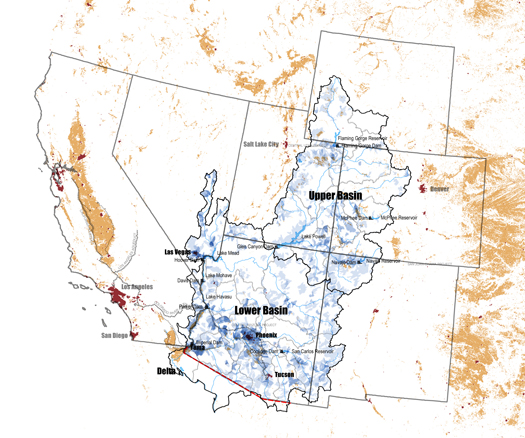
[The Colorado River Basin as a hydrological mega-object; image by the Commonwealth Approach project team: Alex Gonski, Rob Holmes, Rebecca May, and Laurel McSherry.]
I mentioned a little while ago that Laurel McSherry and I would be presenting our work on “The Commonwealth Approach” at the Arid Lands Institute’s Drylands Design Conference near the end of March. I thought I would post the official conference announcement:
The Arid Lands Institute at Woodbury University, in partnership with the California Architectural Foundation (CAF), hosts the Drylands Design Conference from March 22–24, 2012 on the Woodbury University campus in Burbank, California. Shifts in the economy, demographics and climate are causing westerners to rethink the centralized, energy-intensive water systems of the 20th century. Retrofitting the West: Adaptation by Design brings together architects, landscape architects, artists and engineers with leading environmental thinkers, scientists, and renowned conservationists to debate a range of design strategies for the future. More than 225 educators, design professionals and students are expected at the conference where the arid and semi-arid west will be re-examined as a vast field of opportunities for water-smart design innovation at a range of scales, from building systems to infrastructure and landscape spaces.
The Drylands Design Conference kicks off with an opening reception at the Architecture + Design Museum (A+D) in Los Angeles on Thursday, March 22. On view at the museum is Drylands Design, featuring selected work from CAF’s William Turnbull Drylands Design Competition (www.drylandscompetition.org). The exhibition showcases work by architects, landscape architects, engineers, artists, and urban designers responding to the challenges of water scarcity in the face of climate change. With a focus on the US West, the exhibition presents a portfolio of adaptive strategies large and small, rural and urban, high tech and low-carbon. Since no single solution will meet the complex needs of the US West, the exhibition explores a range of approaches for how buildings and parks, houses and streets, industry and agriculture, cities and neighborhoods might adapt to a water-stressed future. Following its run from March 22-April 26, 2012, the exhibition is scheduled to travel in the US and abroad.
In an innovative cross-disciplinary collaboration, ALI and UCLA’s Institute of the Environment and Sustainability provided technical and policy advising to five research award winners chosen from the CAF William Turnbull Drylands Design Competition. At the conference on Friday, March 23, the five award-winning teams will present their design proposals and discuss the policy implications they suggest.
These design case studies and the panel discussions they inform raise important questions about de-coupling energy and water, localizing resources, restructuring watershed governance, the scaleability of small systems, the relationship between water infrastructure and public architectures, and the role of the arts and design in shaping a working public landscape.
The conference puts both young and established design leaders in dialog with thinkers from an array of disciplines, including Wiliam DeBuys, Ph.D., writer and conservationist, author of seven books, the most recent A Great Aridness; Paul Bunje, Ph.D., Managing Director, Los Angeles Regional Collaborative for Climate Action and Sustainability, supported by the UCLA Institute of the Environment and Sustainability; Stephanie Pincetl, Director, Center for Sustainable Urban Systems, UCLA; James Workman, award-winning journalist and author of Heart of Dryness; and Barry Taylor, Ph.D., Professor at Fuller Theological Seminary and Art Center College of Design in Pasadena, California.
On Saturday March 24th, design educators are invited to a workshop on interdisciplinary methods for advancing Drylands Design regionally and globally.
Schools, NGOs, and design firms are encouraged to engage the conference from remote locations by subscribing to live-streaming.
Full details about the conference can be found here, including registration.


[…] home // hide asides // links // index.archive // contact us // about « drylands design conference […]